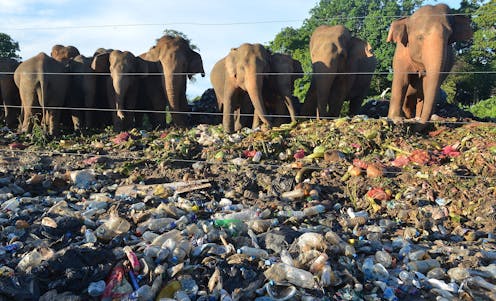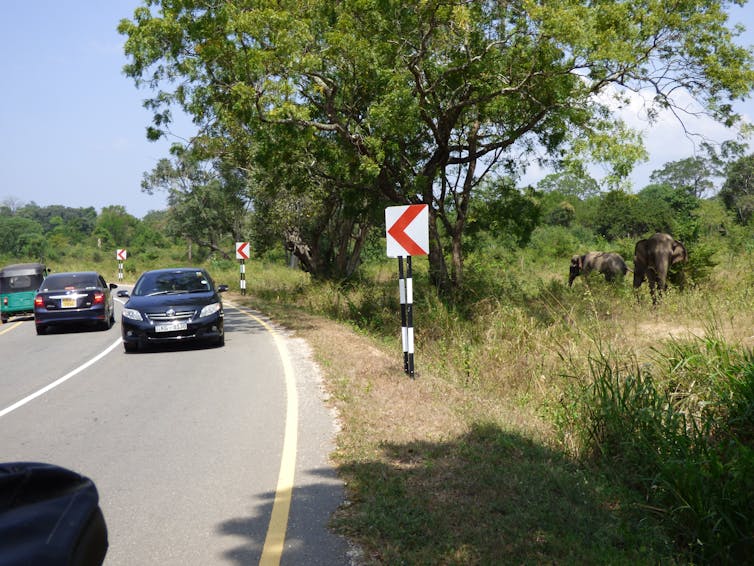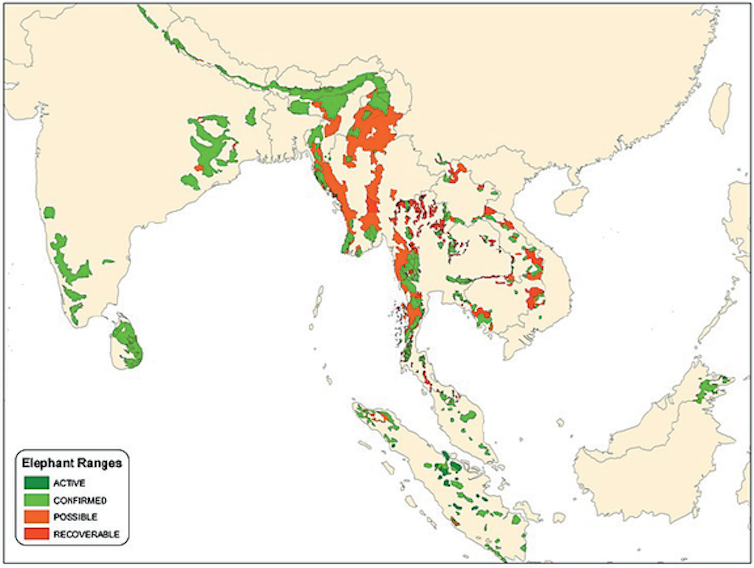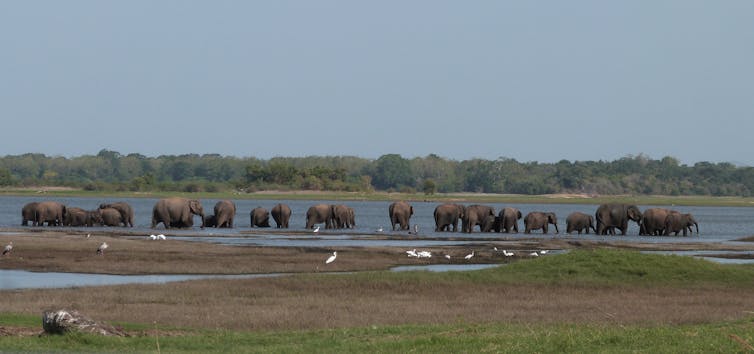
Despite their iconic status and long association with humans, Asian elephants are one of the most endangered large mammals. Believed to number between 45,000 and 50,000 individuals worldwide, they are at risk throughout Asia due to human activities such as deforestation, mining, dam building and road construction, which have damaged numerous ecosystems.
My colleagues and I wanted to know when human actions started to fragment wildlife habitats and populations to the degree seen today. We quantified these impacts by considering them through the needs of this species.
In a newly published study, we examined the centuries-long history of Asian landscapes that once were suitable elephant habitat and often were managed by local communities prior to the colonial era. In our view, understanding this history and restoring some of these relationships may be the key to living with elephants and other large wild animals in the future.

How have humans affected wildlife?
It isn’t easy to measure human impacts on wildlife across a region as large and diverse as Asia and more than a century ago. Historical data for many species is sparse. Museums, for instance, only contain specimens collected from certain locations.
Many animals also have very specific ecological requirements, and there often isn’t sufficient data on these features at a fine scale going far into the past. For instance, a species might prefer particular microclimates or vegetation types that occur only at particular elevations.
For nearly two decades I’ve been studying Asian elephants. As a species, these animals are breathtakingly adaptable: They can live in seasonally dry forests, grasslands or the densest of rain forests. If we could match the habitat requirements of elephants to data sets showing how these habitats changed over time, we knew that we could understand how land-use changes have affected elephants and other wildlife in these environments.
Defining elephant ecosystems
The home-range sizes of Asian elephants can vary anywhere from a few hundred square miles to a few thousand. But since we couldn’t know exactly where elephants would have been centuries ago, we had to model the possibilities based on where they occur today.
By identifying the environmental features that correspond to locations where wild elephants live now, we can distinguish places where they could potentially have lived in the past. In principle, this should represent “good” habitat.
Today many scientists are using this kind of model to identify particular species’ climatic requirements and predict how areas suitable for those species might shift under future climate change scenarios. We applied the same logic retrospectively, using land-use and land-cover types instead of climate change projections.
We drew this information from the Land-Use Harmonization (LUH2) data set, released by a research group at the University of Maryland. The group mapped historical land-use categories by type, starting in the year 850 – long before the advent of nations as we know them today, with fewer large population centers – and extending up to 2015.

My co-authors and I first compiled records of where Asian elephants have been observed in the recent past. We limited our study to the 13 countries that today still contain wild elephants: Bangladesh, Bhutan, Cambodia, China, India, Indonesia, Laos, Malaysia, Myanmar, Nepal, Sri Lanka, Thailand and Vietnam.
We excluded areas where elephant populations are prone to clashing with people, such as intensively farmed landscapes and plantations, in order to avoid classifying these zones as “good” elephant habitat. We included areas with lighter human influence, such as selectively logged forests, because they actually contain great food for elephants.
Next, we used a machine-learning algorithm to determine what types of land use and land cover existed at our remaining locations. This allowed us to map out where elephants could potentially live as of the year 2000. By applying our model to earlier and later years, we were able to generate maps of areas that contained suitable habitat for elephants and to see how those areas had changed over the centuries.

Dramatic declines
Land-use patterns changed significantly on every continent starting with the Industrial Revolution in the 1700s and extending through the colonial era into the mid-20th century. Asia was no exception.
For most areas, we found that suitable elephant habitat took a steep dive around this time. We estimated that from 1700 through 2015 the total amount of suitable habitat decreased by 64%. More than 1.2 million square miles (3 million square kilometers) of land were converted for plantations, industry and urban development. With respect to potential elephant habitat, most of the change occurred in India and China, each of which saw conversion in more than 80% of these landscapes.
In other areas of Southeast Asia – such as a large hot spot of elephant habitat in central Thailand, which was never colonized – habitat loss happened more recently, in the mid-20th century. This timing corresponds to logging concurrent with the so-called Green Revolution, which introduced industrial agriculture to many parts of the world.
Could the past be the key to the future?
Looking back at land-use change over centuries makes it clear just how drastically human actions have reduced habitat for Asian elephants. The losses that we measured greatly exceed estimates of “catastrophic” human impacts on so-called wilderness or forests within recent decades.
Our analysis shows that if you were an elephant in the 1700s, you might have been able to range across 40% of the available habitat in Asia with no problem, because it was one large, contiguous area that contained many ecosystems where you could live. This enabled gene flow among many elephant populations. But by 2015, human activities had so drastically fragmented the total suitable area for elephants that the largest patch of good habitat represented less than 7% of it.
Sri Lanka and peninsular Malaysia have a disproportionately high share of Asia’s wild elephant population, relative to available elephant habitat area. Thailand and Myanmar have smaller populations relative to area. Interestingly, the latter are countries known for their large captive or semi-captive elephant populations.
Less than half of the areas that contain wild elephants today have adequate habitat for them. Elephants’ resulting use of increasingly human-dominated landscapes leads to confrontations that are harmful for both elephants and people.
However, this long view of history reminds us that protected areas alone are not the answer, since they simply cannot be large enough to support elephant populations. Indeed, human societies have shaped these very landscapes for millennia.
Today there is a pressing challenge to balance human subsistence and livelihood requirements with the needs of wildlife. Restoring traditional forms of land management and local stewardship of these landscapes can be an essential part of protecting and recovering ecosystems that serve both people and wildlife in the future.
Shermin de Silva receives funding from the US Fish & Wildlife Asian Elephant Conservation Funds. She is president and founder of Trunks & Leaves Inc. a non-profit organization that works to facilitate evidence-based conservation of Asian elephants and their habitats. de Silva also directs the Udawalawe Elephant Research Project in Sri Lanka, which she initiated in 2005, and is a member of the Asian Elephant Specialist Group of the IUCN Species Survival Commission.
This article was originally published on The Conversation. Read the original article.







